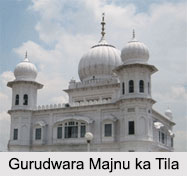 Gurudwara Majnu ka Tila is dedicated to Guru Nanak who sanctified this place in 15th century. It is part of Delhi. The esteemed place of Majnu ka Tila Gurudwara, New Delhi, has seen many discourses among yogis, Sufis, fakirs and Guru Nanak. Guru Har Gobind Singh, the 6th Guru also stayed at the Gurudwara when Emperor Jahangir invited him. Gradually, this place invited several attentions and acquired importance and a Gurudwara was eventually built here. The complex also houses a vast well. Every year the birth anniversary of Khalsa is celebrated at the Gurudwara on Baisakhi with much boom and a `langar` (free deliverance of food) is arranged for all.
Gurudwara Majnu ka Tila is dedicated to Guru Nanak who sanctified this place in 15th century. It is part of Delhi. The esteemed place of Majnu ka Tila Gurudwara, New Delhi, has seen many discourses among yogis, Sufis, fakirs and Guru Nanak. Guru Har Gobind Singh, the 6th Guru also stayed at the Gurudwara when Emperor Jahangir invited him. Gradually, this place invited several attentions and acquired importance and a Gurudwara was eventually built here. The complex also houses a vast well. Every year the birth anniversary of Khalsa is celebrated at the Gurudwara on Baisakhi with much boom and a `langar` (free deliverance of food) is arranged for all.
Location of Gurudwara Majnu ka Tila
Majnu ka Tila Gurudwara is situated opposite Timarpur Colony away from Khyber Pass, Delhi. It is situated on the right bank of Yamuna River.
Legends of Gurudwara Majnu ka Tila
There is an interesting story behind the construction of the Gurudwara. It is believed that a `fakir` (Muslim hermit) used to be alive on the banks of the River Yamuna during the rule of Sultan Sikandar Lodi. His only aim was to carry people across the river for free and to meditate and pray all day long. He desired so much for the `darshan` (view) of God that the local people started calling him `Majnu`.
One fine day, he had the chance to meet Guru Nanak lastly. Guru Nanak blessed him and helped him to achieve enlightenment. Henceforth, he became an enthusiastic follower of Guru Nanak. It was his hermitage on the banks the Yamuna River that later came to be known as Majnu-ka-Tila. It is also believed that `General Baghel Singh", who conquered Delhi in 1783 and held it under his control for a few months, also encamped at MajnuÂKa-Tilla. It is also said that, it was General Baghel Singh who raised a small charter at this sanctified place to take on the mark of respect of the Sikh Gurus. The small, historical old marble Gurdwara, which exists even today, was constructed by Maharaja Ranjit Singh who also contributed it with a "jagir".





















